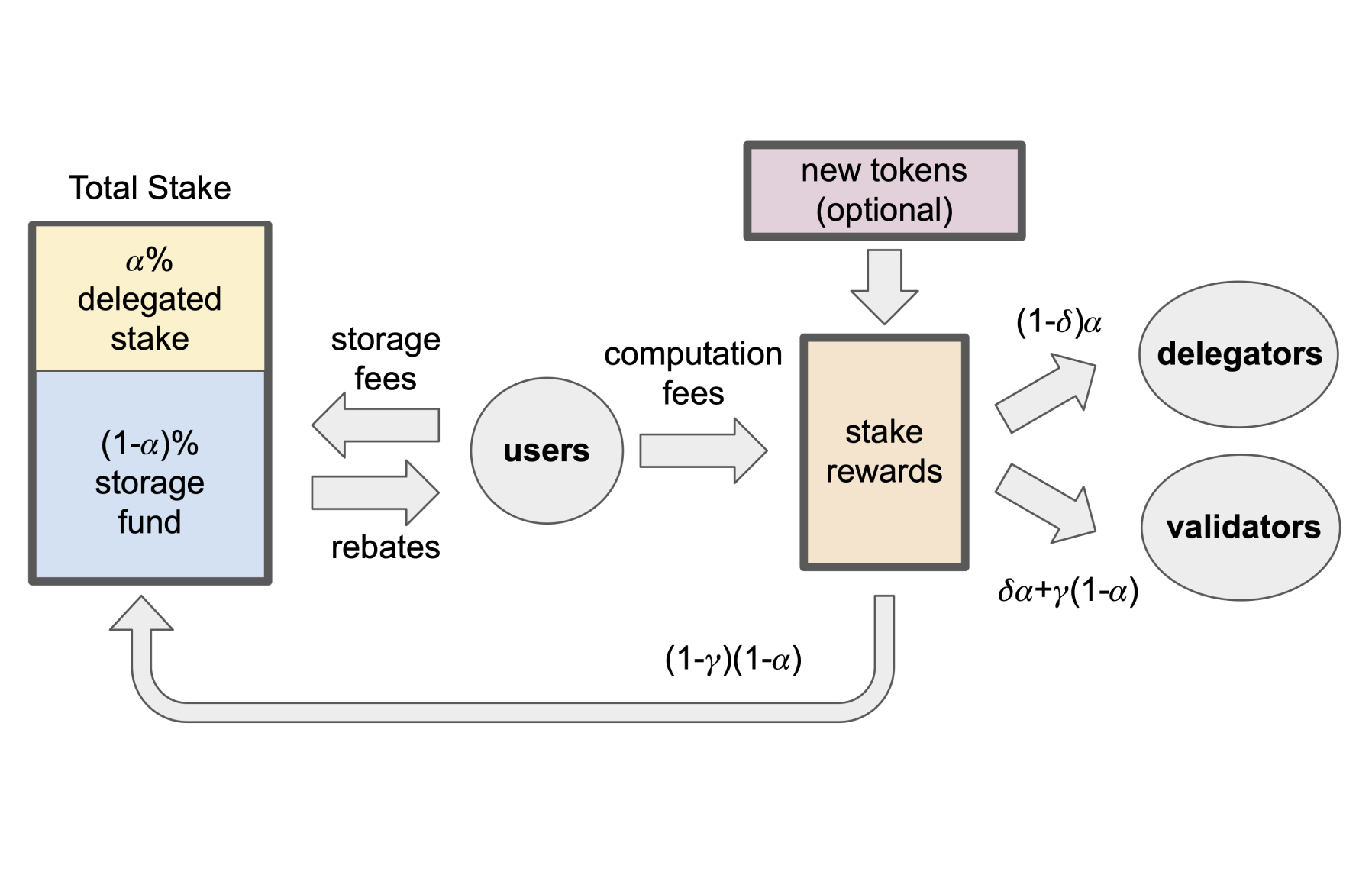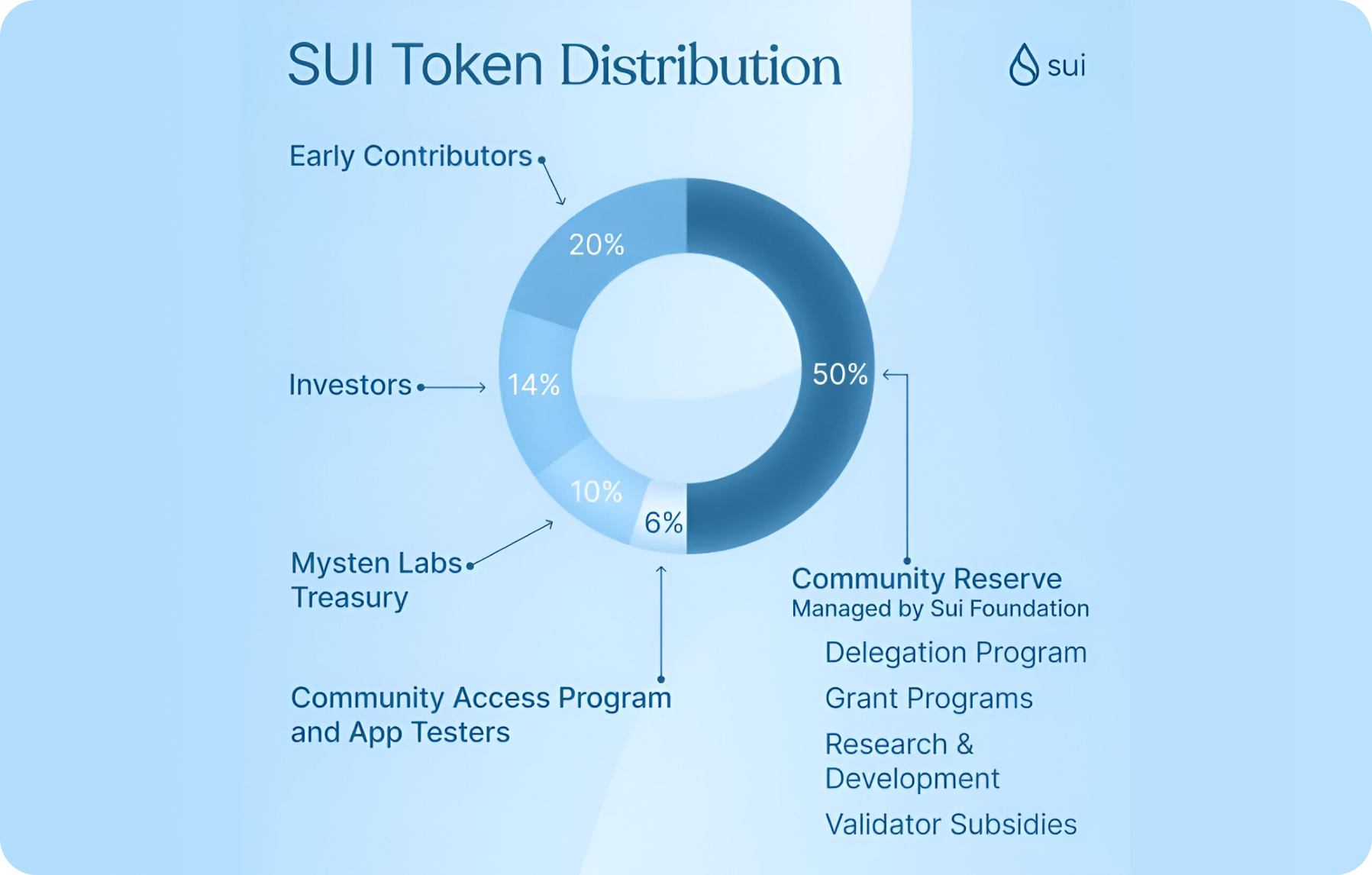SUI Ecosystem Overview

Key Insights
- SUI ecosystem leverages a unique object-based data model and parallel transaction processing to achieve high scalability and performance, setting it apart from other blockchain platforms like Solana, Avalanche, and Arbitrum.
- SUI has garnered significant support from prominent venture capital firms and organizations, including Andreessen Horowitz (A16z), Electric Capital, Coinbase Ventures, Binance Labs, and Samsung Next, which strengthens its position in the blockchain ecosystem.
- The use of the Move programming language for smart contracts offers robust security features and flexibility, promoting safer and more efficient development of decentralized applications.
What Is SUI
SUI blockchain is a platform developed by Mysten Labs that aims to provide high-speed and scalable solutions for decentralized applications (dApps) and smart contracts.
SUI ecosystem offers a modern infrastructure designed to enhance the performance of smart contracts and support decentralized solutions.
SUI network was created in response to evolving conditions within the blockchain industry. In 2019, Meta launched an ambitious blockchain initiative known as Libra, which was later rebranded to Diem.
This project faced significant regulatory pushback, ultimately leading to its closure. As a result, the Libra developers decided to leverage their experience and expertise to form a new company — Mysten Labs, which then initiated the SUI project.
Mysten Labs Team (SUI Team)
- Evan Cheng
CEO, responsible for strategic development and overall project management. His duties include defining strategic directions and team leadership.
- Adeniyi Abiodun
Chief Product Officer (CPO), focused on product development, market implementation, and successful operation.
- Sam Blackshear
Chief Technology Officer (CTO), responsible for technical leadership, managing development processes, andimplementing advanced technologies.
- George Danezis
Chief Scientist, focusing on research and innovation that drive the platform's technological advancement.
SUI Blockchain: Launch and Development
At its inception, SUI network faced several challenges. Initially, there was a plan for a token airdrop; however, after a warning from the U.S. Securities and Exchange Commission (SEC), the strategy shifted to a private sale.
To participate in this sale, users had to join a whitelist by participating in events or being active in the project's Discord channel before February 1, 2023.
Participants in the sale were able to purchase SUI tokens at $0.03, and after the sale concluded, the token's price increased to $1.2, drawing significant attention from major investment funds.
SUI Blockchain Architecture
- Object-oriented Data Model
SUI blockchain uses an object-oriented data model where assets and states are represented as objects. This model simplifies data handling and ensures transparency in operations.
- Flexibility and Convenience
Data on the SUI ecosystem is presented as objects with unique identifiers, properties, and methods, enabling developers to manage data efficiently.
- Transaction Integrity
The SUI blockchain allows multiple operations on objects within a single transaction, reducing the need for multiple confirmations.
- Transparency of Changes
All changes to the state of objects are recorded on the SUI network, making it easy to track the history of modifications and operations.

- Deterministic State
- Change Logging
Changes in the state of objects are logged on the SUI blockchain, creating a transparent history of all operations and enabling the restoration of previous states.
- Reliability Assurance
Deterministic operations on the SUI network prevent errors such as double spending, ensuring the system's reliabilityand predictability.
- Historical Tracing
The complete history of changes to objects is stored on the SUI network crypto infrastructure, allowing for easy tracking and analysis of system modifications.
- Parallel Transaction Processing
The SUI ecosystem supports parallel transaction processing, which significantly increases network performance.
- Parallelism Mechanism
Transactions within the SUI network crypto can be processed simultaneously if they do not conflict, enabling the system to handle a larger number of transactions per unit time, crucial for high-activity applications.
- Performance Optimization
Parallel processing on the SUI blockchain reduces wait times and improves system responsiveness, which is critical for scalable dApps.
- Transaction Isolation
Each transaction in the SUI network is executed in an isolated context, preventing conflicts between parallel operations and reducing errors and issues related to concurrent data access.
- Validator Network
The SUI blockchain uses a decentralized validator network to ensure consensus and security.
- Decentralized Validation
Validators on the SUI network confirm transactions and create new blocks, promoting decentralization and reducing the risk of network attacks.
- Verification Process
Validators in the SUI ecosystem verify transactions and maintain network integrity, preventing manipulation and attacks.
- Incentives and Security
Validators are rewarded for their tasks, motivating them to work honestly and efficiently. There are also penalties for violators, helping to ensure the system's honesty and reliability of the SUI blockchain.
SUI Security and Consensus
The SUI blockchain ensures data security and network integrity through modern consensus protocols and protective mechanisms.
- Proof-of-Stake (PoS) Consensus Protocol
The SUI network uses a modified PoS protocol which provides high energy efficiency and transaction processing speed. Validators stake their tokens, contributing to network integrity.
- Reliability Guarantee
The token stakes of validators in the SUI network crypto system ensure their vested interest in maintaining network integrity and security.
- Attack Protection
The SUI blockchain implements measures against various attacks, such as double-spending and Sybil attacks, helping prevent security threats and maintain network stability.
- Rapid Response
The SUI network incorporates protocols for quick response to potential threats and failures, promoting rapid vulnerability resolution.
SUI Modularity and Extensibility
The architecture of the SUI blockchain is designed for modularity and easy extensibility.
- Modular Structure
The SUI ecosystem consists of independent modules, such as transaction processing, data storage, and consensus mechanisms. This allows updates and improvements to individual components without disrupting the entire network.
- Updates and Enhancements
Modularity in the SUI network facilitates the implementation of new features and optimizations, adapting the system to changing requirements.
- Horizontal Scalability
The SUI blockchain supports horizontal scaling, allowing new nodes and resources to be added as the load grows, ensuring the network can handle an increasing number of users and transactions.
- Traffic Adaptation
Flexible resource scaling allows the system to adapt to traffic changes and application requirements, maintaining high performance across the SUI ecosystem.
SUI Smart Contracts with Move Language
SUI uses the Move programming language for writing smart contracts, offering specialized capabilities for development in the SUI network crypto environment.
- Security and Access Control
Move is designed with a focus on security, providing strict access control and protection against common vulnerabilities, helping prevent errors and abuses on the SUI blockchain.
- Resource-Oriented Model
Move supports resource-oriented programming, where resources (e.g. tokens) have clear rules for use and transfer, preventing asset management issues within the SUI ecosystem.
- Flexibility and Extensibility
Move allows the creation of modular and reusable components, simplifying the development and testing of smart contracts on the SUI network.
SUI Tokenomics
Functions of the SUI Token

- Medium of Exchange
Used for payments, exchanges, and accumulation within the SUI network.
- Staking and Collateral
Serves for staking and collateral, enabling validator participation in consensus and block creation.
- Liquidity
The SUI token provides liquidity in the network, forming the foundation of the SUI ecosystem economic model.
- Transaction Fees
Used to pay fees for transactions performed in the SUI network.
- Governance
Token holders can participate in project governance by voting on important issues.
SUI Ecosystem Participants
- Users
Individuals who create, modify, or transfer digital assets and use applications on the SUI network.
- Stakers
Users who stake their tokens and pay fees, contributing to SUI network operation and earning rewards.
- Validators
Participants who process transactions and maintain SUI network stability, ensuring its security and reliability.
SUI Token Distribution

- 50% of tokens are allocated for the SUI network community, including rewards for staking and validation.
- 20% of tokens are provided to participants of the public sale.
- 14% of tokens are allocated to investors and backers who supported the SUI blockchain in its early stages.
- 10% of tokens remain with Mysten Labs for further development and project management.
- 6% of tokens are reserved for rewards to testers and ambassadors, who help with SUI ecosystem promotion and testing.
Token Unlock Schedule

SUI Competitive Analysis
SUI blockchain is a platform positioned to compete with other high-performance solutions like Solana, Avalanche, and Arbitrum. Let’s examine the key aspects of this comparison.
Sui vs Solana
- Speed and Scalability
Solana achieves high transaction speeds through its unique Proof-of-History (PoH) mechanism, which simplifies time synchronization across nodes. This allows the network to process thousands of transactions per second (TPS).
- Differences
Unlike Solana's PoH, the SUI network uses an object-based data model and parallel transaction processing. This model offers greater flexibility in data management and the ability to execute multiple operations simultaneously, potentially being more effective for specific types of applications.
Sui vs Avalanche
- Consensus Protocol
Avalanche employs a unique consensus protocol that enables high performance and low latency. This model ensures scalability and rapid transaction processing within the network.
- Differences
Unlike Avalanche, which relies on a specialized consensus protocol, the SUI network crypto does not utilize a specific consensus method. Instead, the SUI blockchain leverages its object-based data model and modular system architecture to achieve high performance and scalability.
Sui vs Arbitrum
- Layer-2 Solution
Arbitrum is a Layer-2 solution for Ethereum that enhances scalability and reduces fees by processing transactions off-chain and then confirming the results on the main network.
- Differences
Unlike Arbitrum, which operates within the Ethereum ecosystem, the SUI network offers its own architecture, featuring an object-based data model and parallel transaction processing. This provides high performance and scalability without relying on existing blockchains.
SUI Ecosystem: Partnerships
- A16z (Andreessen Horowitz)
A leading venture capital fund specializing in technology startups, including blockchain and cryptocurrencies, backing the development of the SUI ecosystem.
- Electric Capital
An investment fund focused on supporting and funding blockchain projects and cryptocurrencies, contributing to the expansion of the SUI network.
- Coinbase Ventures
The venture arm of the cryptocurrency exchange Coinbase, specializing in investments in blockchain startups.
- Binance Labs
The research and investment division of the cryptocurrency exchange Binance.
- Samsung Next
A venture fund and incubator that is part of Samsung Electronics, specializing in investments in startups and new technologies, including blockchain technologies and cryptocurrencies.
Users can get SUI or any other cryptocurrency for fiat or crypto on SimpleSwap.
Summary
The analysis of the SUI ecosystem highlights its ambitious approach to addressing scalability and performancechallenges in the blockchain industry.
By utilizing a unique object-based data model, deterministic state management, and parallel transaction processing, SUI blockchain aims to create a platform capable of effectively supporting decentralized applications and smart contracts with a high level of performance and reliability.
Originating from the shift in Meta's blockchain initiative, the SUI network represents a significant technological advancement focused on meeting the growing demands of both users and developers.
Its sophisticated consensus mechanisms, modular architecture, and innovative smart contract development approaches, such as the Move programming language, provide SUI with competitive advantages in the race against other high-speed blockchain solutions.
SUI tokenomics and strategic token distribution, along with partnerships with leading venture capital firms and organizations, support its sustainable development and popularization.
Ultimately, the SUI network aims to build a flexible and scalable infrastructure that can adapt to changing market demands and conditions.
In a rapidly evolving blockchain ecosystem, SUI ecosystem presents a promising alternative for developers and users seeking high-performance and secure solutions.
The future success of the platform will depend on its ability to maintain innovation, scalability, and collaboration with key industry participants.
The information in this article is not a piece of financial advice or any other advice of any kind. The reader should be aware of the risks involved in trading cryptocurrencies and make their own informed decisions. SimpleSwap is not responsible for any losses incurred due to such risks. For details, please see our Terms of Service.


